75 Scatter plots
Written by Haoluan Chen and last updated on 7 October 2021.
75.1 Introduction
In this lesson, you will learn how to:
- Create a scatter plot in R using ggplot2 package
- Customize your scatter plot
Prerequisite skills include:
Highlights:
- Create and customize a scatter-plot
75.3 What is a Scatter plot?
A scatter plot is a visual representation of two numerical variables. It allows you to see the correlation between the variables.
Here, we have a dataset mtcars extracted from the 1974 Motor Trend US magazine.
head(mtcars)
#> mpg cyl disp hp drat wt qsec vs am
#> Mazda RX4 21.0 6 160 110 3.90 2.620 16.46 0 1
#> Mazda RX4 Wag 21.0 6 160 110 3.90 2.875 17.02 0 1
#> Datsun 710 22.8 4 108 93 3.85 2.320 18.61 1 1
#> Hornet 4 Drive 21.4 6 258 110 3.08 3.215 19.44 1 0
#> Hornet Sportabout 18.7 8 360 175 3.15 3.440 17.02 0 0
#> Valiant 18.1 6 225 105 2.76 3.460 20.22 1 0
#> gear carb
#> Mazda RX4 4 4
#> Mazda RX4 Wag 4 4
#> Datsun 710 4 1
#> Hornet 4 Drive 3 1
#> Hornet Sportabout 3 2
#> Valiant 3 1wt is the weight (1000lbs), mpg is the miles per gallon for the car. Now we are interested in the relationship between these variables among 32 different cars.
Using the following code, we can create our basic scatter plot in R!
# Basic scatter plot
ggplot(data = mtcars, mapping = aes(x=wt, y=mpg)) +
geom_point()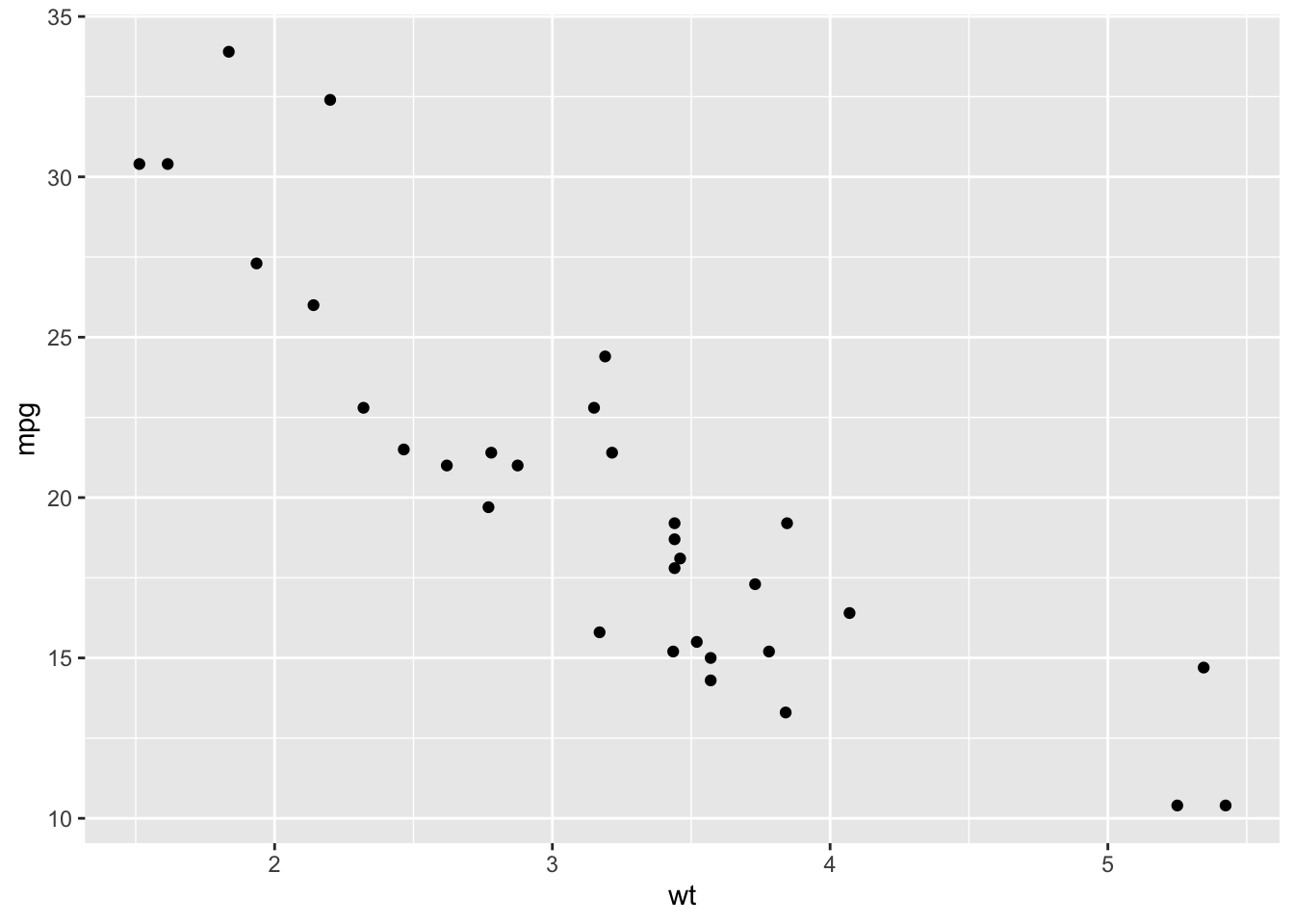
In this plot, each dot shows one car’s miles per gallon versus its weight. We can see a decreasing trend among the weight and the miles per gallon for the car.
75.4 Arguments
75.4.1 Basic scatter plot
- The size and the shape of points can be changed using the function geom_point() as follow :
geom_point(size, shape)
# Change the point size
ggplot(mtcars, aes(x=wt, y=mpg)) +
geom_point(size=2)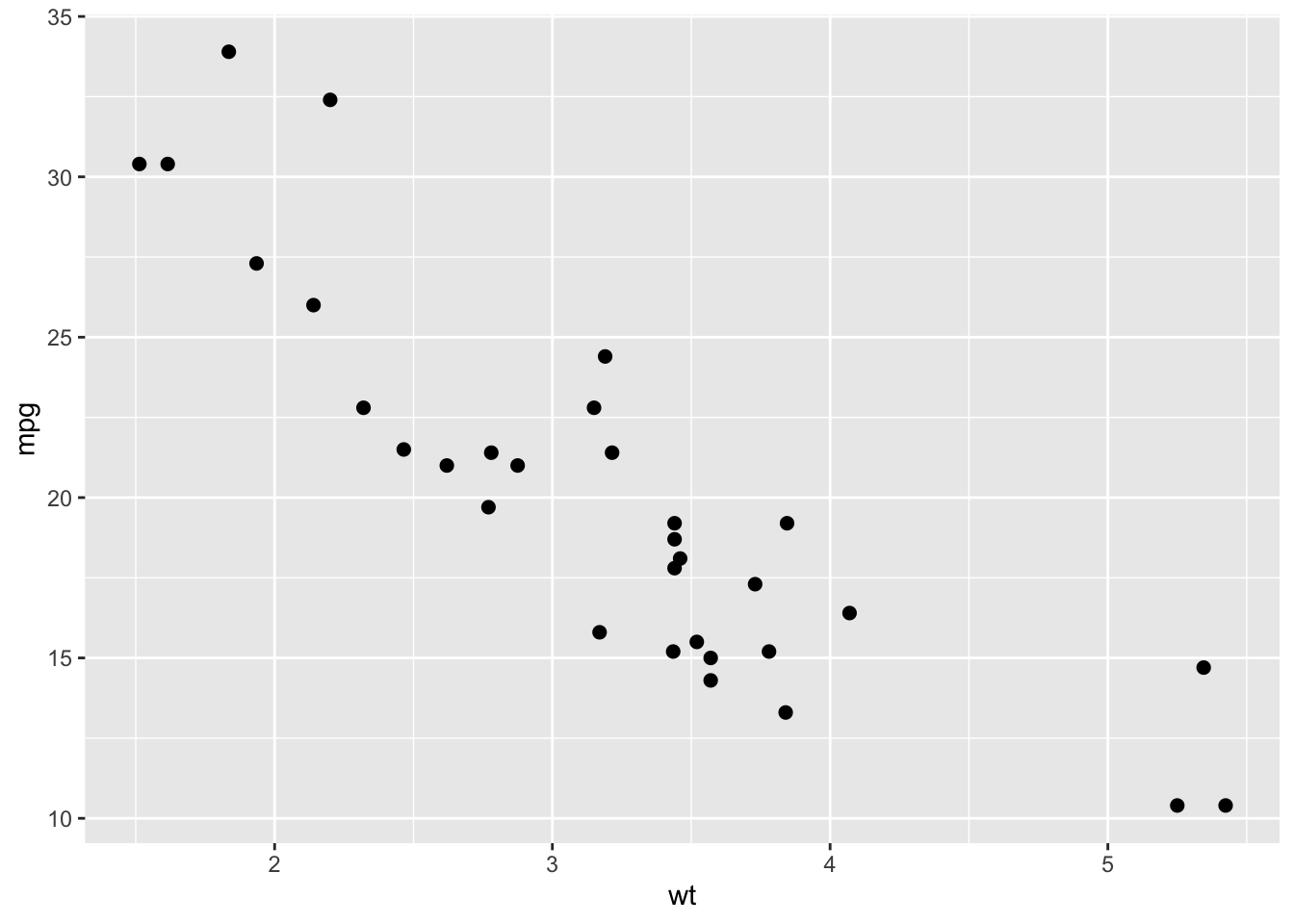
# Change the point shape
ggplot(mtcars, aes(x=wt, y=mpg)) +
geom_point(shape=23)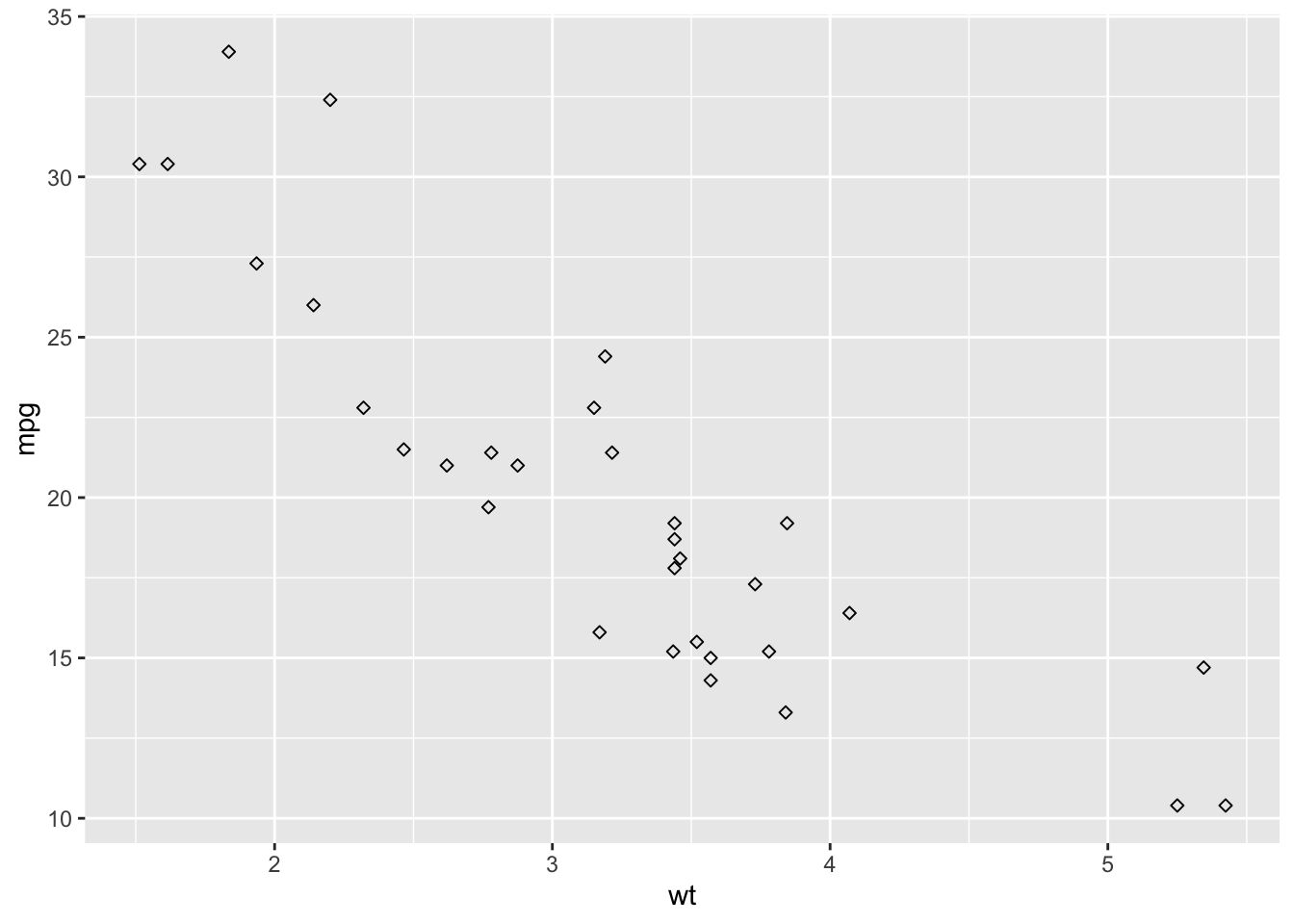
From the above figures, we know that we can change different sizes and shapes by changing parameters in geom_point().
- The size of the points can be controlled by the values of a continuous variable as in the example below.
cyl is the number of cylinders of the car.
# Change the point size by the values of cyl
ggplot(mtcars, aes(x=wt, y=mpg)) +
geom_point(aes(size=cyl))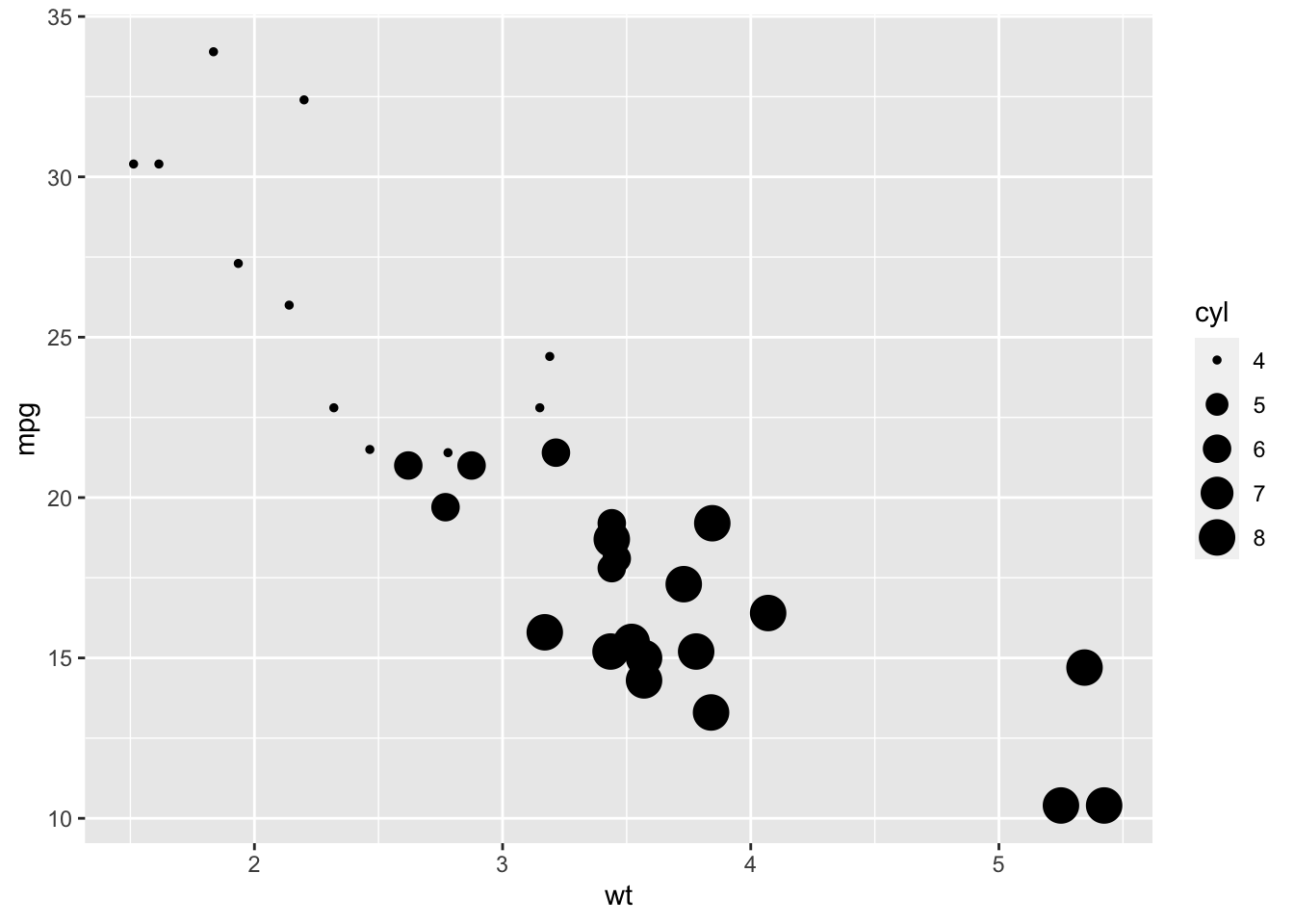
75.5 Change the appearance of the point
We can also change the color of the border of the point and filling of the point using the function geom_point() as follow :
geom_point(color, fill)
# change shape, color, size
ggplot(mtcars, aes(x=wt, y=mpg)) +
geom_point(shape=23, color="darkred",size=3)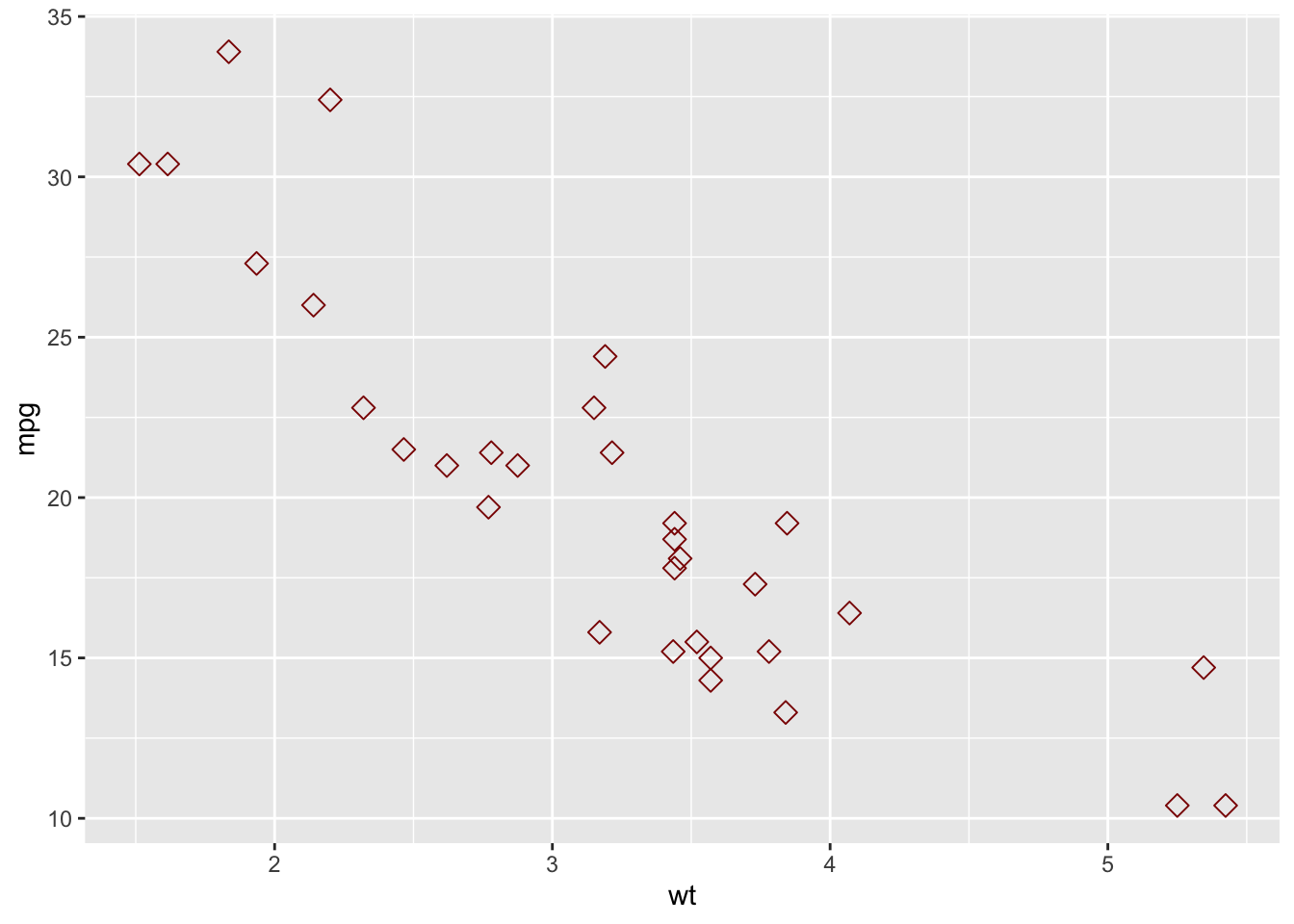
# change shape, color, fill, size
ggplot(mtcars, aes(x=wt, y=mpg)) +
geom_point(shape=23, fill="blue", size=3)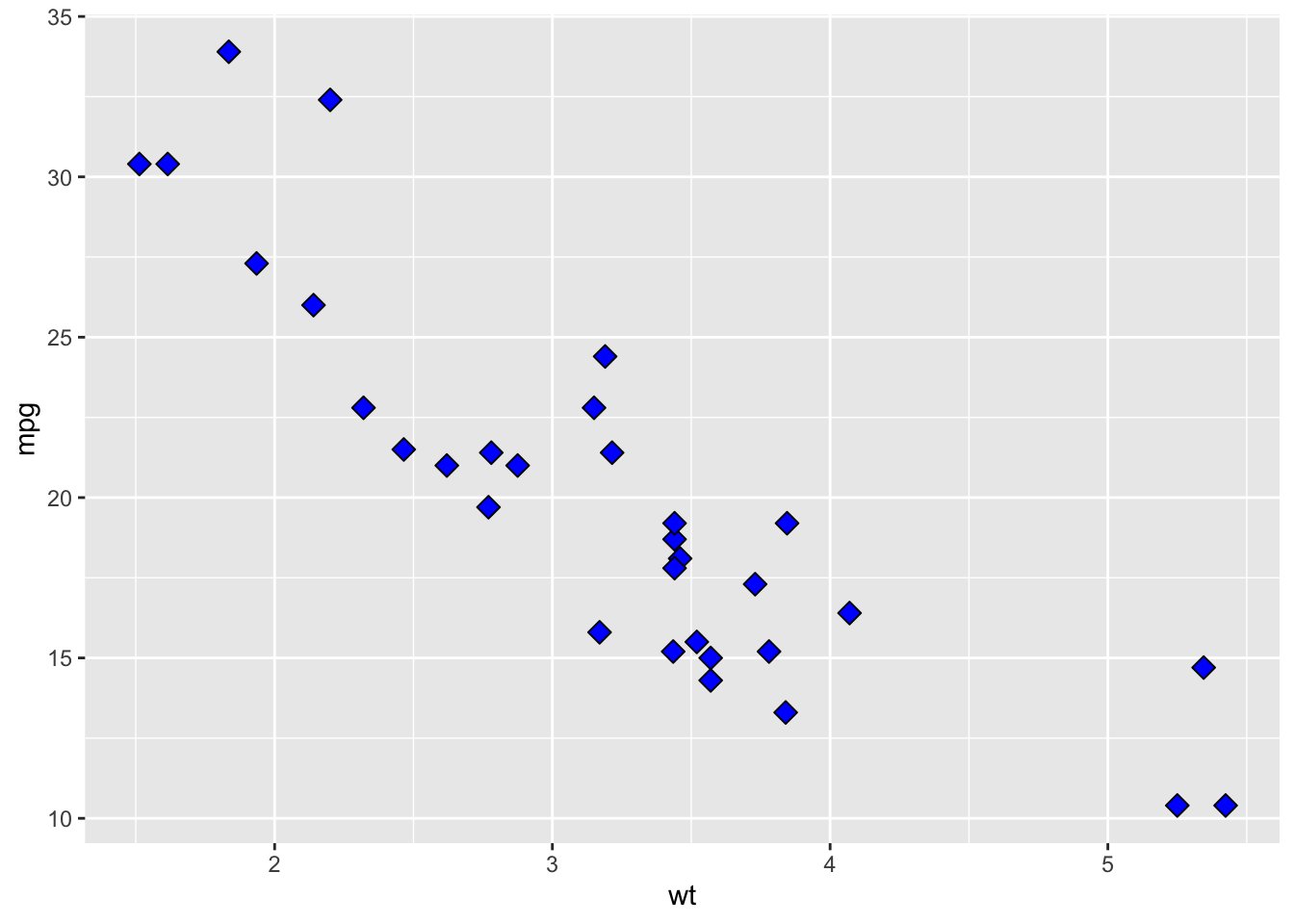
75.6 Scatter plots with multiple groups
We can also change the points, colors, and shapes based on a variable. In the R code below, point shapes, colors, and sizes are controlled by the levels of the factor variable cyl :
We are using as.factor here because cyl is a double data type in the dataset. Using as.factor() can transform cyl into factor data type
# Change point shapes by the levels of cyl
ggplot(mtcars, aes(x=wt, y=mpg)) +
geom_point(aes(shape=as.factor(cyl)))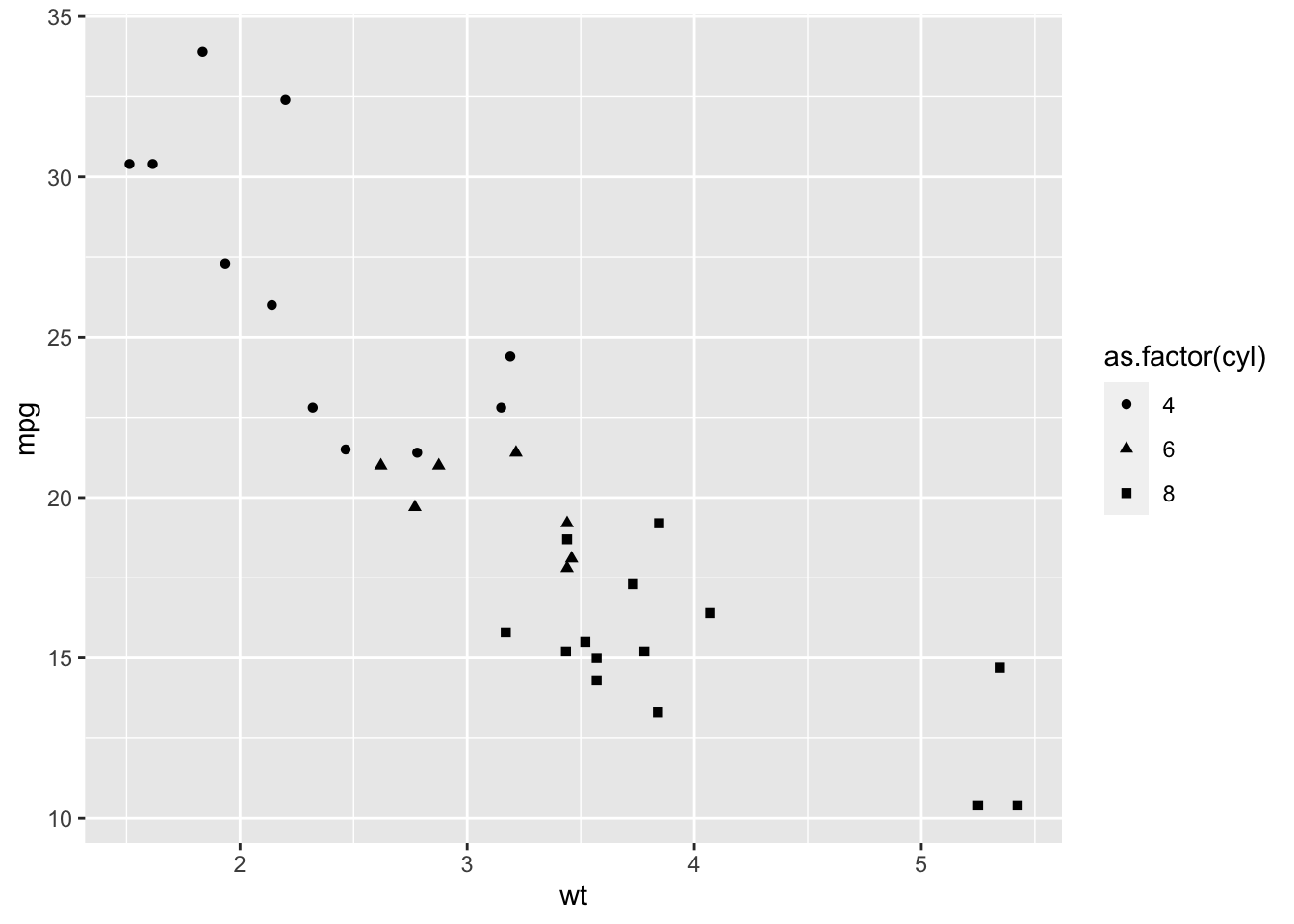
# Change point shapes and colors
ggplot(mtcars, aes(x=wt, y=mpg)) +
geom_point(aes(shape=as.factor(cyl), color=cyl))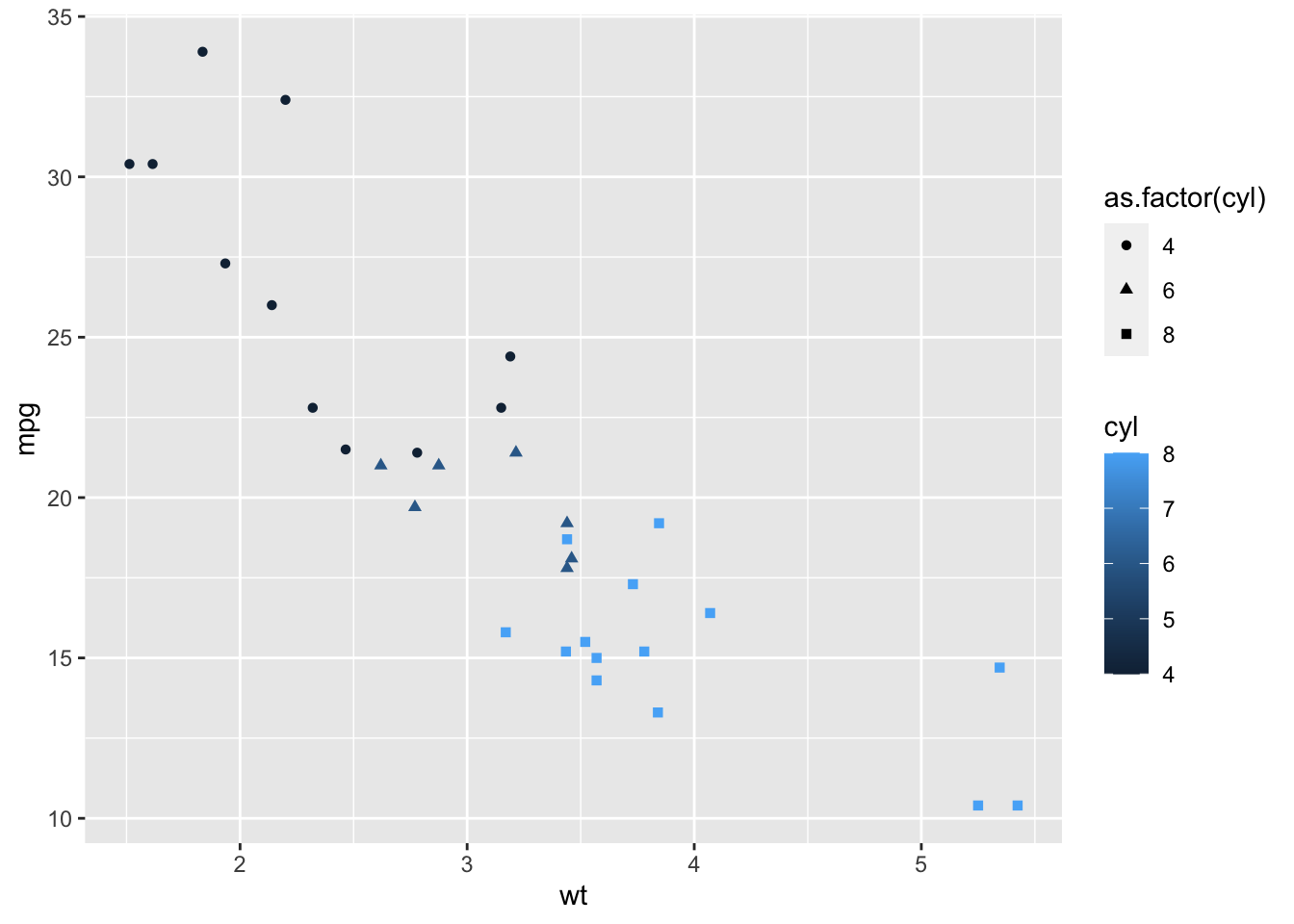
# change point shapes, colors and sizes
ggplot(mtcars, aes(x=wt, y=mpg)) +
geom_point(aes(shape=as.factor(cyl), color=cyl, size=cyl))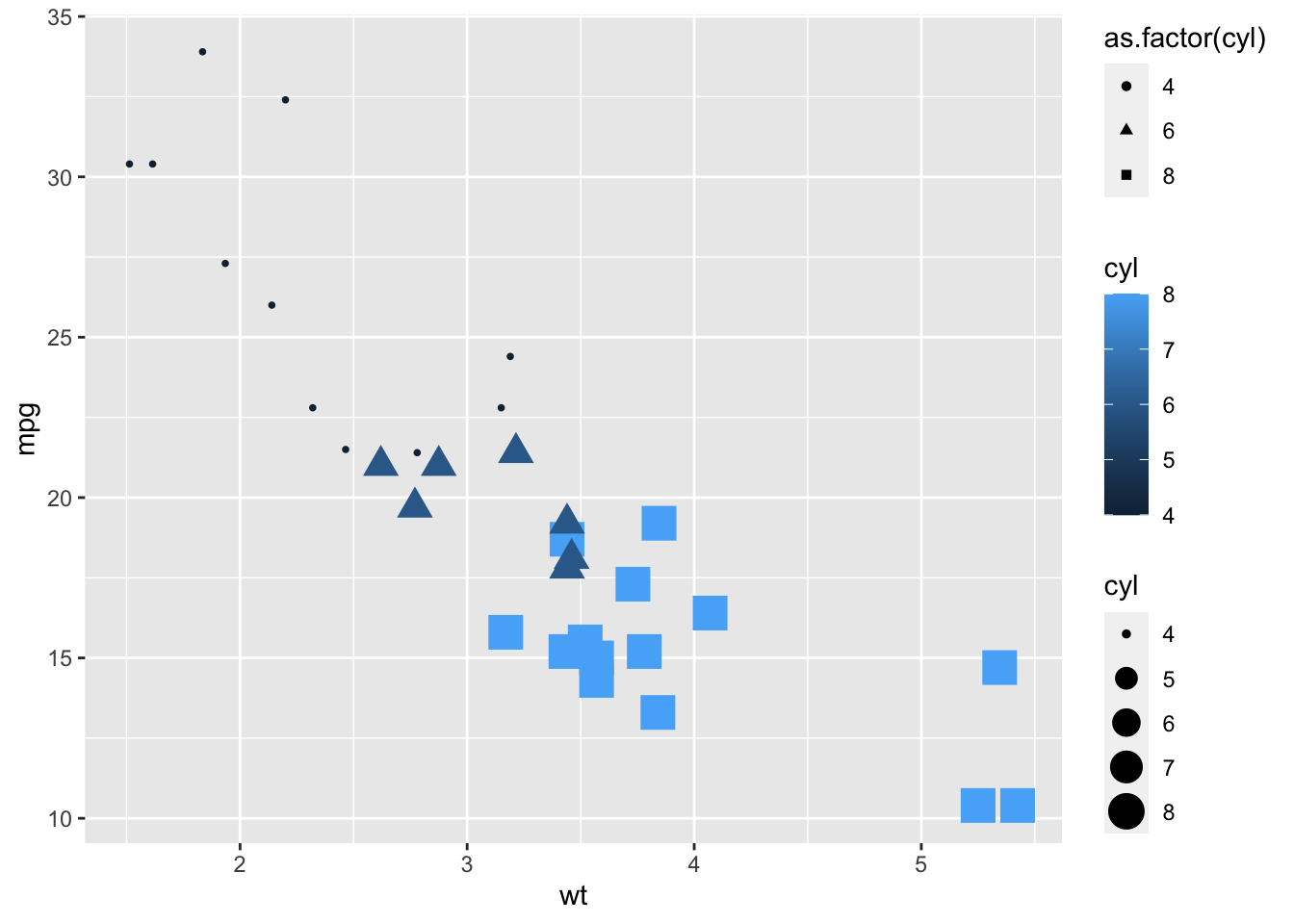
75.8 Exercise 1
Create a scatter plot to see the correlation between the hp and wt in mtcars
mtcars
#> mpg cyl disp hp drat wt qsec vs
#> Mazda RX4 21.0 6 160.0 110 3.90 2.620 16.46 0
#> Mazda RX4 Wag 21.0 6 160.0 110 3.90 2.875 17.02 0
#> Datsun 710 22.8 4 108.0 93 3.85 2.320 18.61 1
#> Hornet 4 Drive 21.4 6 258.0 110 3.08 3.215 19.44 1
#> Hornet Sportabout 18.7 8 360.0 175 3.15 3.440 17.02 0
#> Valiant 18.1 6 225.0 105 2.76 3.460 20.22 1
#> Duster 360 14.3 8 360.0 245 3.21 3.570 15.84 0
#> Merc 240D 24.4 4 146.7 62 3.69 3.190 20.00 1
#> Merc 230 22.8 4 140.8 95 3.92 3.150 22.90 1
#> Merc 280 19.2 6 167.6 123 3.92 3.440 18.30 1
#> Merc 280C 17.8 6 167.6 123 3.92 3.440 18.90 1
#> Merc 450SE 16.4 8 275.8 180 3.07 4.070 17.40 0
#> Merc 450SL 17.3 8 275.8 180 3.07 3.730 17.60 0
#> Merc 450SLC 15.2 8 275.8 180 3.07 3.780 18.00 0
#> Cadillac Fleetwood 10.4 8 472.0 205 2.93 5.250 17.98 0
#> Lincoln Continental 10.4 8 460.0 215 3.00 5.424 17.82 0
#> Chrysler Imperial 14.7 8 440.0 230 3.23 5.345 17.42 0
#> Fiat 128 32.4 4 78.7 66 4.08 2.200 19.47 1
#> Honda Civic 30.4 4 75.7 52 4.93 1.615 18.52 1
#> Toyota Corolla 33.9 4 71.1 65 4.22 1.835 19.90 1
#> Toyota Corona 21.5 4 120.1 97 3.70 2.465 20.01 1
#> Dodge Challenger 15.5 8 318.0 150 2.76 3.520 16.87 0
#> AMC Javelin 15.2 8 304.0 150 3.15 3.435 17.30 0
#> Camaro Z28 13.3 8 350.0 245 3.73 3.840 15.41 0
#> Pontiac Firebird 19.2 8 400.0 175 3.08 3.845 17.05 0
#> Fiat X1-9 27.3 4 79.0 66 4.08 1.935 18.90 1
#> Porsche 914-2 26.0 4 120.3 91 4.43 2.140 16.70 0
#> Lotus Europa 30.4 4 95.1 113 3.77 1.513 16.90 1
#> Ford Pantera L 15.8 8 351.0 264 4.22 3.170 14.50 0
#> Ferrari Dino 19.7 6 145.0 175 3.62 2.770 15.50 0
#> Maserati Bora 15.0 8 301.0 335 3.54 3.570 14.60 0
#> Volvo 142E 21.4 4 121.0 109 4.11 2.780 18.60 1
#> am gear carb
#> Mazda RX4 1 4 4
#> Mazda RX4 Wag 1 4 4
#> Datsun 710 1 4 1
#> Hornet 4 Drive 0 3 1
#> Hornet Sportabout 0 3 2
#> Valiant 0 3 1
#> Duster 360 0 3 4
#> Merc 240D 0 4 2
#> Merc 230 0 4 2
#> Merc 280 0 4 4
#> Merc 280C 0 4 4
#> Merc 450SE 0 3 3
#> Merc 450SL 0 3 3
#> Merc 450SLC 0 3 3
#> Cadillac Fleetwood 0 3 4
#> Lincoln Continental 0 3 4
#> Chrysler Imperial 0 3 4
#> Fiat 128 1 4 1
#> Honda Civic 1 4 2
#> Toyota Corolla 1 4 1
#> Toyota Corona 0 3 1
#> Dodge Challenger 0 3 2
#> AMC Javelin 0 3 2
#> Camaro Z28 0 3 4
#> Pontiac Firebird 0 3 2
#> Fiat X1-9 1 4 1
#> Porsche 914-2 1 5 2
#> Lotus Europa 1 5 2
#> Ford Pantera L 1 5 4
#> Ferrari Dino 1 5 6
#> Maserati Bora 1 5 8
#> Volvo 142E 1 4 2
mtcars %>% ggplot(aes(hp, wt)) + geom_point()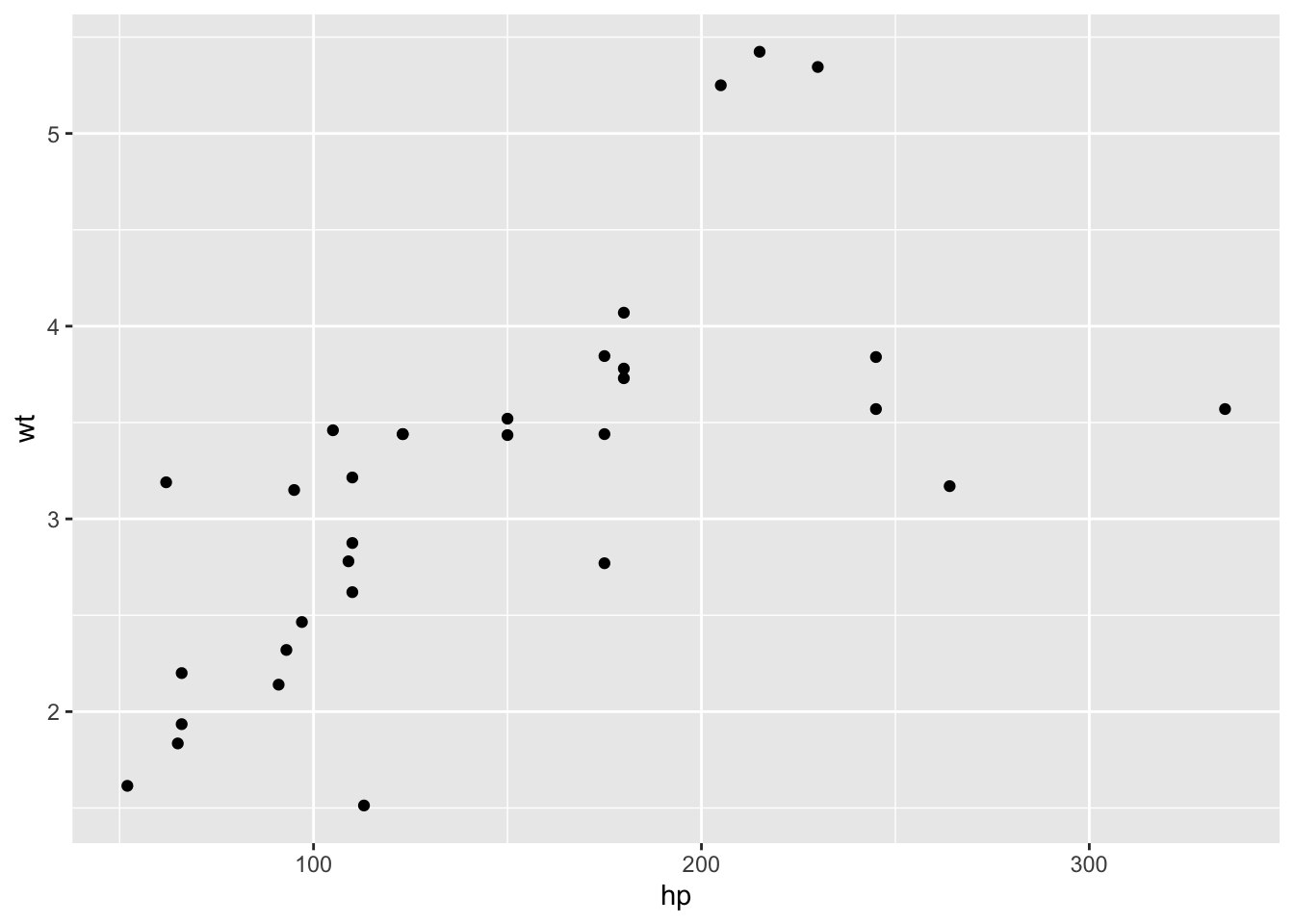
75.9 Exercise 2
Set the size of the scatter plot in previous question to 5
mtcars %>% ggplot(aes(hp, wt)) + geom_point(size = 5)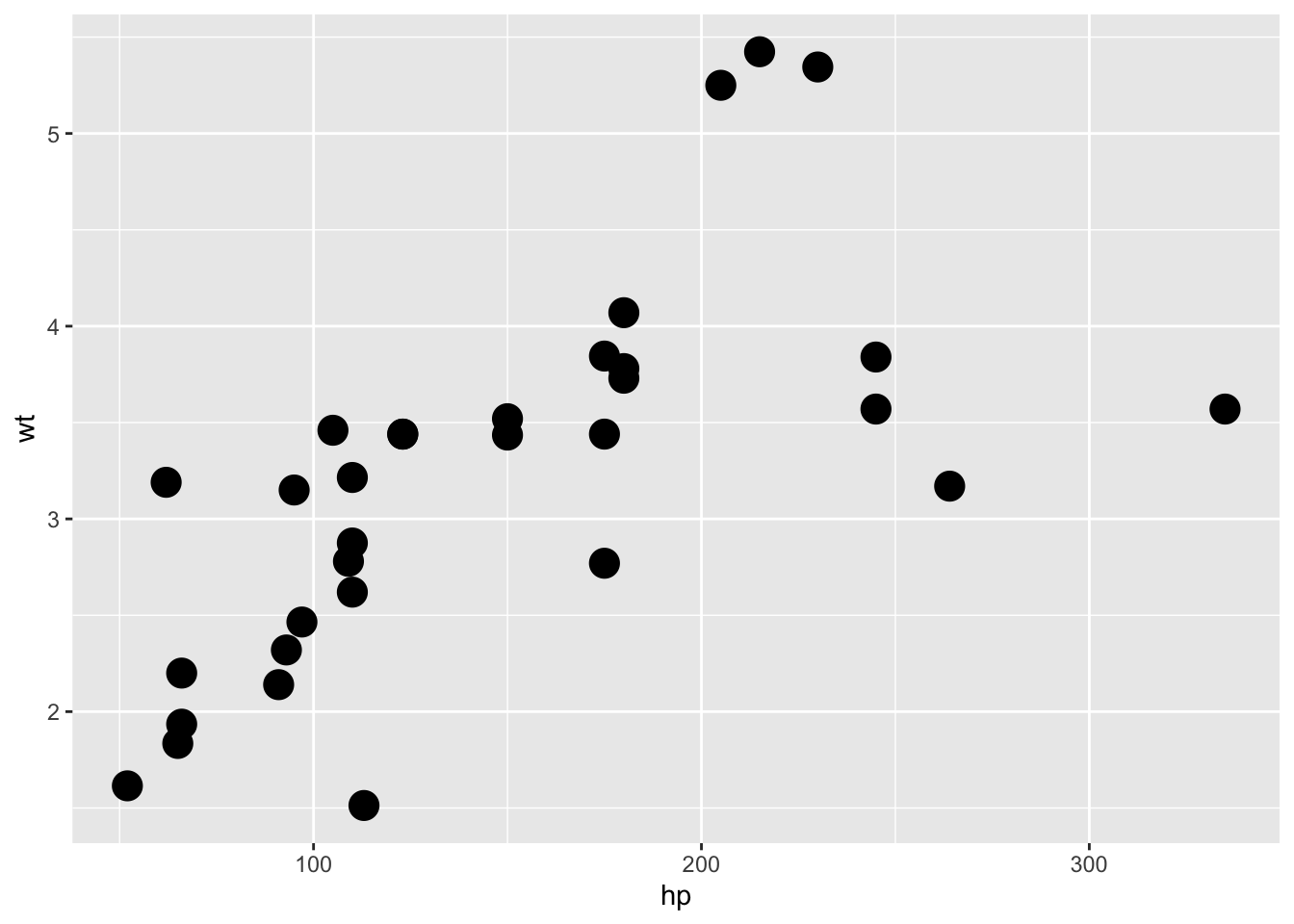 ## Exercise 3
Set the color of the scatter plot in previous question to blue
## Exercise 3
Set the color of the scatter plot in previous question to blue
mtcars %>% ggplot(aes(hp, wt)) + geom_point(size = 5, col = "blue")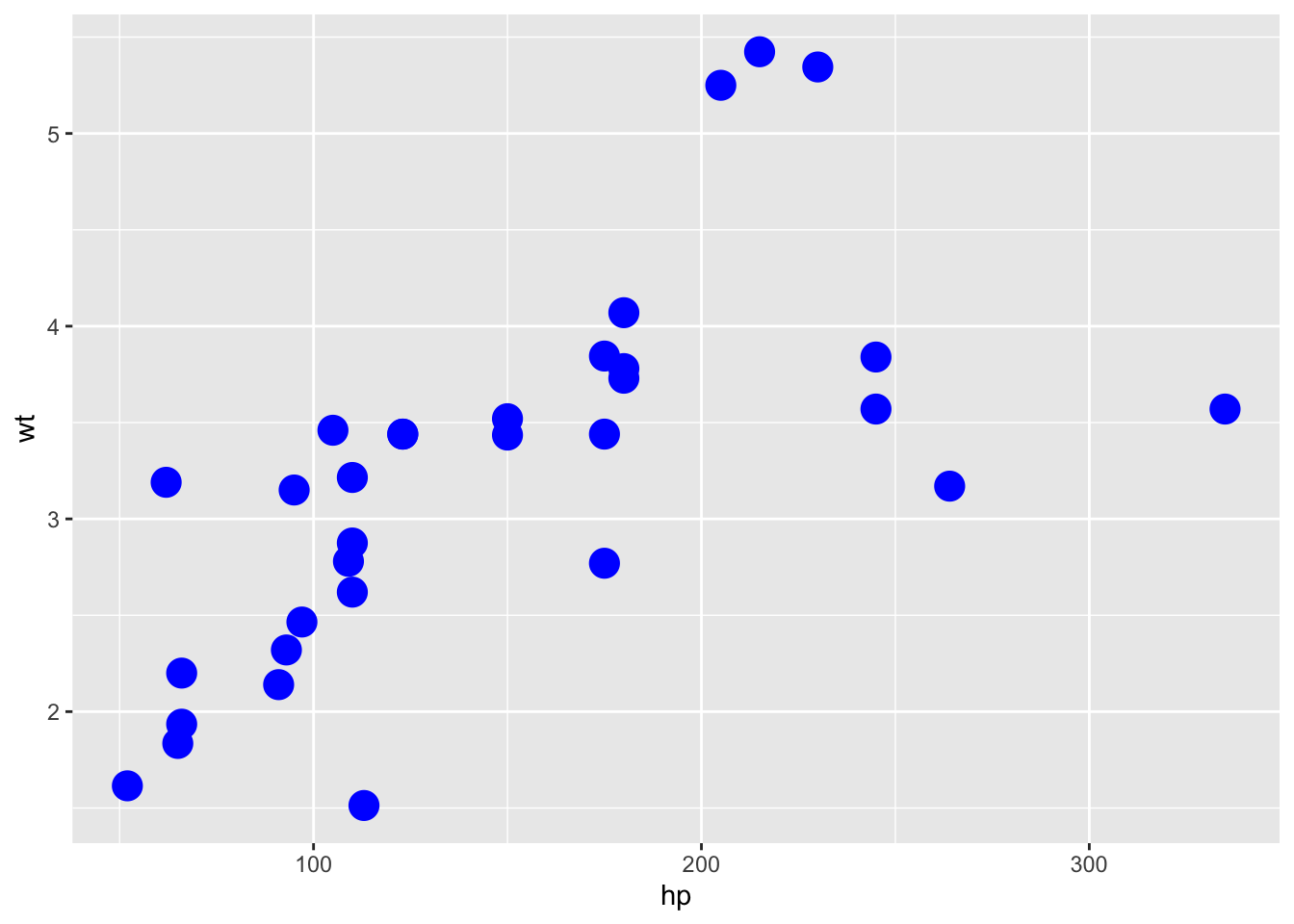
75.10 Common Mistakes & Errors
- If you want to change the colors and shapes based on a variable in your dataset, make sure it is a factor type dataset
- connect ggplot() and geom_point() by using
+not%>%
75.11 Next Steps
You may use geom_smooth() function to add a regression line on your scatter plot to get a clear pattern of your data.
ggplot(data = mtcars, mapping = aes(x=wt, y=mpg)) +
geom_point() +
geom_smooth(method='lm')
#> `geom_smooth()` using formula 'y ~ x'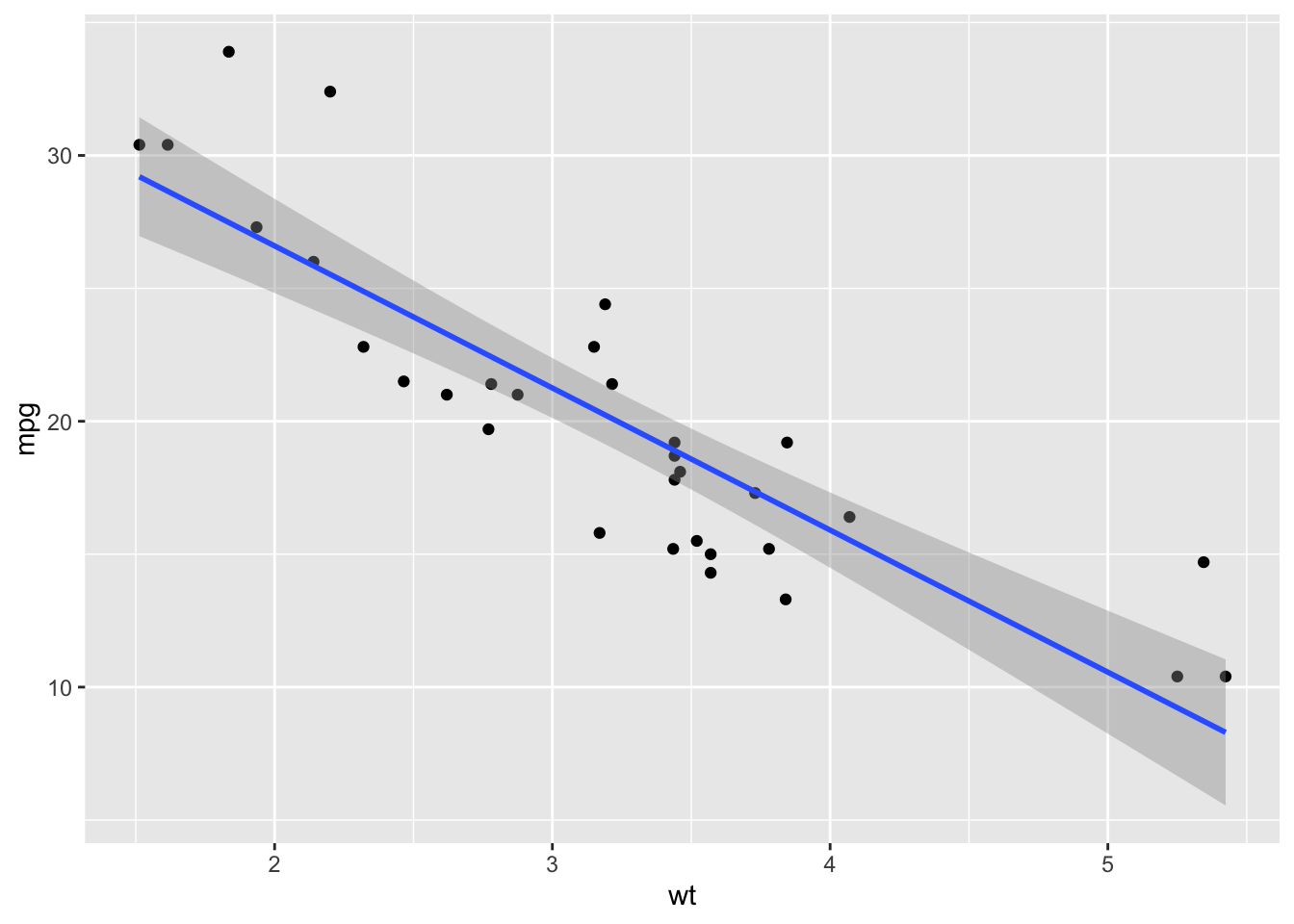
Here is a guide for creating interesting scatter plots! http://www.sthda.com/english/wiki/ggplot2-scatter-plots-quick-start-guide-r-software-and-data-visualization
You may also change the title, axis, theme of your scatter plot!
http://www.sthda.com/english/wiki/ggplot2-title-main-axis-and-legend-titles
75.12 Exercises
75.12.1 Question 1
A scatter plot is a visual representation of two numerical variables. a. True b. False
75.12.2 Question 2
Scatter plot allow you to visualize the correlation between two numerical variables. a. True b. False
75.12.3 Question 3
Scatter plot allow you to visualize the distribution of two numerical variables. a. True b. False
75.12.4 Question 4
How do you change the shape of the dots in your scatter plot?
a. Add a shape parameter in geom_point()
b. Add a shape parameter in ggplot()
c. Add a shape layer
d. You cannot change the shape of the dots
75.12.5 Question 5
What can you do to customize your scatter-plot? a. shape b. color c. size d. All of the above
75.12.6 Question 6
What is the required argument for goem_point()?
a. color
b. size
c. shape
d. All of the above
e. None of the above
75.12.7 Question 7
How to add a regression line on your scatter plot to get a clear pattern of your data.
a. You cannot add a regression line on scatter plot.
b. Add a smooth = True in ggplot()
c. Add a smooth = True in goem_point()
d. Use geom_smooth()
75.12.8 Question 8
Does following code work? ggplot(mtcars, aes(x=wt, y=mpg)) %>% geom_point(shape=23, fill=“blue,” size=3) a. Yes b. No